
When Dr. Hamilton performs cataract or refractive lens exchange surgery, he is removing the natural lens of the eye and replacing it with an intraocular lens implant (IOL). Ideally, the IOL implanted should correct vision for all Vision Zones.
The 3 Vision Zones:

NEAR (reading, cell phone)

INTERMEDIATE (computer, grocery store shelf)

DISTANCE (driving, TV).
Trifocal IOLs
Standard Monofocal IOLs
Standard, insurance covered IOLs are called monofocal or “one focus”. These lenses do not correct for astigmatism and are focused at one vision zone only, typically distance. This means the recipient of the monofocal IOL will require glasses to see clearly at all distances. Moreover, if the monofocal IOL is chosen to target distance vision, near vision will be completely non-functional and blurry without reading glasses. Menus, pricetags, cellphone, tablets, laptop, newspaper and other reading material, putting on make-up: all these tasks will require assistance in the form of spectacles or magnifying device (e.g. mirror).
If you have a healthy eye, without macular degeneration, moderate to severe glaucoma or severe dry eye, Dr. Hamilton will likely offer an advanced intraocular lens implant to maximize your visual function. After a full examination, including advanced diagnostic imaging of all parts of your eye, and after getting to know your specific lifestyle requirements, Dr. Hamilton will make a recommendation as to the best advanced IOL option to address your needs.
Advanced IOL Technologies
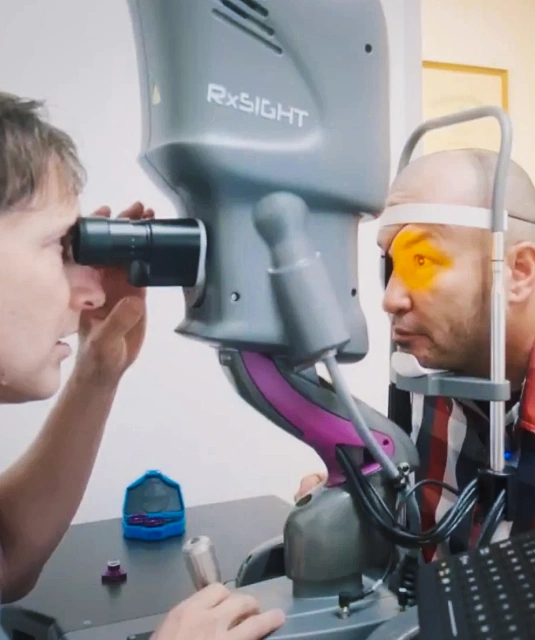
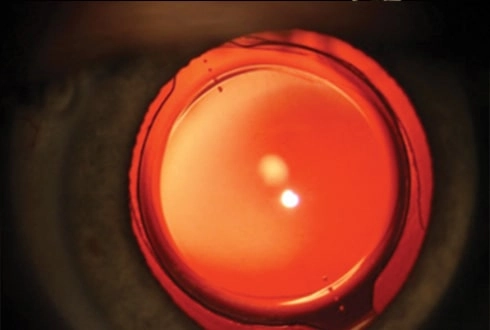
Monofocal Toric IOL
For patients with significant amounts of astigmatism, Dr. Hamilton will recommend a Toric IOL. This IOL design has astigmatism correction built into the IOL optic and will reduce or eliminate the need for astigmatism correction in glasses following surgery. The image on the left shows a Monofocal Toric IOL in the eye. Note the 4 dots at 11 and 5 o’clock. These dots signify the astigmatic axis of the Toric IOL that needs to be properly oriented, uniquely in each eye, to effectively reduce astigmatism.
How Do Monofocal IOLs Work?
Astigmatism, which occurs due to a cornea that has a football rather than a basketball shape, can create blur and double images when viewing objects at any distance. Standard, insurance based monofocal IOLs do not correct astigmatism. Dr. Hamilton will often recommend an advanced monofocal Toric IOL to patients with significant astigmatism who have other issues that compromise their visual function, such as advanced glaucoma or significant macular degeneration. In these patients, the monofocal Toric IOL will maximize the potential vision available in the compromised eye. In an otherwise healthy eye with significant astigmatism, Dr. Hamilton will typically offer a multifocal extended depth of focus, Toric IOL. After a thorough evaluation of your eye, Dr. Hamilton will discuss in detail with you which option he feels is best for your individual situation.
Are There Side Effects?
There are risks and potential side effects to any surgical procedure, including a surgery as common as cataract surgery. Because the Toric IOL must be specifically aligned in the eye to yield good visual results, accurate preoperative measurement and the skill of an experience eye surgeon are key to success. In addition, the use of laser and intraoperative aberrometry technology improves the accuracy of the Toric IOL positioning and resulting vision. Even in the hands of a skilled surgeon, there is a very small chance that the implant could slightly rotate inside the eye which could lead to blurry vision. The most important way to prevent this from happening is to wear the shield Dr. Hamilton gives you for at least 24 hours and avoid rubbing the eye during this critical time that the lens needs to seat into place. Should the Toric IOL rotate, correction would require a minor surgical revision.
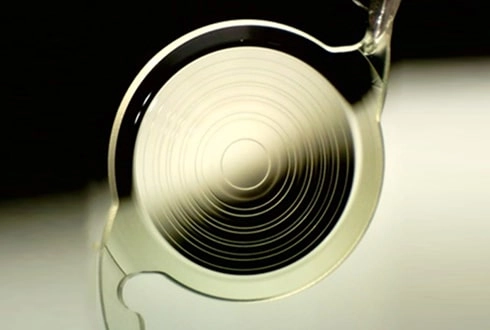
Multifocal/EDOF IOL
(Toric available)
Having to frequently take reading glasses on and off is inconvenient. Because of this, a person might wear reading glasses around their neck, scatter multiple pairs around the house or wear progressive/bifocals/trifocals all the time. With today’s advanced lens procedures, patients now have the opportunity to greatly reduce or eliminate their dependence on glasses.
How Does a Multifocal IOL Work?
Unlike conventional monofocal ”single zone” intraocular lenses (IOLs), multifocal IOLs are lens implants that are designed to help patients see at all three vision zones using different points of focus. The vast majority of multifocal IOL patients experience freedom from glasses for tasks such as driving, watching TV, using their cell phone and computer, looking at photos, reading magazines, price tags, product labels, receipts, and menus. A similar technology is called Extended Depth of Focus (EDOF) and performs is a very similar fashion to a Multifocal IOL.
With bifocal glasses, you look through the top part of the lens for distance and through the bottom area of the lens for near. A multifocal IOL, designed using advanced technologies such as diffractive and refractive optics, is entirely different, providing multiple focal zones simultaneously. Your brain will learn to automatically select the focus that is appropriate for the task at hand. This phenomenon is much like having a conversation in a room where there is background music; the brain will “tune out” one to listen to the other.
There is a learning curve for using this new, advanced optical design. For example, patients often will have to learn the optimal distance or “sweet spot” for holding reading material as it will likely differ from what the patient was used to before surgery. In addition, mulitfocal IOL technology splits the incoming light into focal points for multiple vision zones. As a result, bright light is very helpful to improve contrast and visual acuity. For example, additional light may be necessary to read in dim light conditions (e.g. menu in dimly lit restaurant). Multifocal/EDOF IOLs come in toric versions to reduce astigmatism.
Are There Side Effects?
All Multifocal/EDOF IOL patients will notice some halos, glare, starbursts or rings around lights at night, particularly car headlights, taillights and traffic lights. These halos are different from and less problematic than those typically caused by cataracts. Fortunately, these halos become less noticeable and distracting over time as the brain learns to selectively ignore them through a process called neuro-adaptation. This is the same process that allows us to ignore background noise such as traffic sounds or an air conditioning fan. You may have a watch or earrings on but don’t notice them unless they are pointed out. How quickly these adjustments are made by the brain varies for different individuals. Experience has shown that neuro-adaptation is a gradual process that occurs over several months. Halos are most noticeable immediately following the first implant surgery as your brain is presented instantaneously with new optics in only one eye. The unoperated eye still has the old natural lens the brain is used to. Once the second eye surgery occurs, the new optics are present in both eyes and become the new “normal” for the brain.
Will I Need Additional Procedures to Achieve the Best Result?
Much like contact lenses or glasses, a multifocal/EDOF IOL comes in more than 60 different “powers”. As with prescription eyeglasses or contact lenses, it is important to match the appropriate IOL power to your eye. When prescribing eyeglasses or contact lenses, we utilize trial and error to preview different lens powers to determine which one you see best with (“Which one is better, one or two?”). However, because the multifocal/EDOF IOL is implanted inside the eye, and only after your natural lens (cataract) has been removed, it is impossible for you to “preview” various IOL powers prior to surgery.
Fortunately, Dr. Hamilton is well versed in the very latest mathematical formulas developed to calculate the best IOL power, based on pre-operative measurements of your eye’s dimensions. Although these formulas are quite accurate in most patients, there are individual variables that prevent this process from being 100% perfect. Fortunately, Dr. Hamilton uses laser assistance during cataract surgery which includes intraoperative aberrometry (Hyperlink to Laser Cataract Surgery), technology which allows for optical measurement of the eye intraoperatively, following cataract removal but prior to selection of the IOL power to implant. This improves Dr. Hamilton’s ability to choose the best IOL power for your eye. In particular, individuals who are extremely nearsighted, farsighted, have high amounts of astigmatism, or patients who have had previous refractive surgery (e.g. RK, PRK, LASIK), are more likely to end up with an IOL power that is not optimal and, therefore, benefit most from intraoperative aberrometry measurements. Multifocal/ EDOF IOLs are high performance devices and, accordingly, require precisely tuned optics. If the IOL power is not optimal, the multifocal/EDOF IOL will not perform as well as desired. In these situations, a patient may discover the vision is adequate for most tasks and that wearing a very thin pair of glasses helps them out in certain situations (e.g. night driving). Alternatively, an additional procedure, such as LASIK or PRK, can be performed to optimize the outcome. There is a 10% chance that a secondary procedure like LASIK will be necessary to fine tune the spectacle free vision. Another option is to perform a remove and exchange procedure where the IOL is switch to one of a different power.
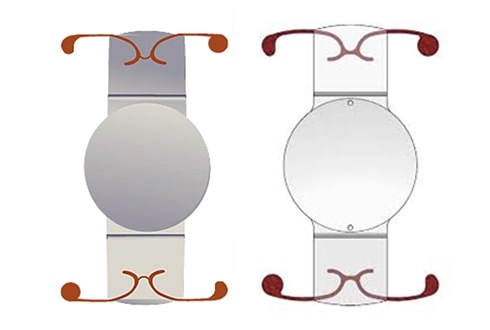
Accommodative IOL
(Toric available)
Having to frequently take reading glasses on and off is inconvenient for many people. Because of this, a person might wear reading glasses around their neck, scatter multiple pairs around the house or wear bifocals all the time. With today’s advanced lens procedures, patients now have a choice in the type of lens that is implanted during cataract or clear lens extraction surgery. Unlike conventional monofocal “single zone” intraocular lenses (IOLs), accommodating IOLs are designed to help patients see at multiple vision zones, either distance/intermediate or intermediate/near without glasses.
How Does an Accommodating IOL Work?
The Accommodating IOL is designed to mimic the movement of the natural crystalline lens of the eye. When we are younger, the natural lens is very flexible and easily moves back and forth within the eye as we change our visual focus from near to intermediate to distance zones. As we age however, most commonly in our early to mid 40s, the eye loses its flexibility and can no longer easily accommodate those changes in our focus. To imitate the action of the young natural lens, the accommodating IOLs are able to move and/or change shape inside the eye to allow focus across more than one zone. While current accommodating IOLs are able to provide some range of focus, they cannot replicate the amazing range of vision you had when you were 20 years old. Today’s accommodating IOLs can provide vision across 2 contiguous zones: distance/intermediate or intermediate/near but not all 3 zones. Current accommodating IOLs come in toric versions to reduce astigmatism.
Are There Side Effects?
There are risks and potential side effects to any surgical procedure, including a surgery as common as cataract surgery. Accommodating IOLs are limited in the range of vision they can provide compared to multifocal IOLs. To achieve a full range of vision without glasses, accommodative IOLs typically need to be set differently in the two eyes: one for distance/intermediate and the other for intermediate/near. This set-up, called monovision, is often used in contact lens wearers in their 40’s and 50’s to achieve a full range of vision. During the adaptation period to this monovision setup, patients will often notice a “ghost” image around the primary, sharper image, depending on lighting conditions. Through neuro-adaptation, the brain learns to ignore this ghost image over time. One advantage of Accommodative IOLs over Multifocal IOLs is a much lower incidence of night time glare, halos, and starbursts.
Will I Need Additional Procedures to Achieve the Best Result?
Much like contact lenses or glasses, an accommodating IOL comes in more than 60 different “powers”. As with prescription eyeglasses or contact lenses, it is important to match the appropriate IOL power to your eye. When prescribing eyeglasses or contact lenses, we utilize trial and error to preview different lens powers to determine which one you see best with (“Which one is better, one or two?”). However, because the accommodating IOL is implanted inside the eye, and only after your natural lens (cataract) has been removed, it is impossible for you to “preview” various IOL powers prior to surgery. Furthermore, once it is implanted we cannot as easily exchange the IOL as we could with glasses or contact lenses.
Fortunately, Dr. Hamilton is well versed in the very latest mathematical formulas developed to calculate the best IOL power, based on pre-operative measurements of your eye’s dimensions. Although these formulas are quite accurate in most patients, there are individual variables that prevent this process from being 100% perfect.
Dr. Hamilton uses laser assistance during cataract surgery which includes intraoperative aberrometry. This technology allows Dr. Hamilton to take optical measurement of the eye during surgery, following cataract removal but prior to selection of the IOL power. This improves Dr. Hamilton’s ability to choose the best IOL power for your eye. In particular, individuals who are extremely nearsighted, farsighted, have high amounts of astigmatism, or patients who have had previous refractive surgery (e.g. RK, PRK, LASIK), are more likely to end up with an IOL power that is not optimal and, therefore, benefit most from intraoperative aberrometry measurements.
Accommodating IOLs are high performance devices and, accordingly, require precisely tuned optics. If the IOL power is not optimal, it will not perform as well as desired. In these situations, a patient may discover the vision is adequate for most tasks and that wearing a very thin pair of glasses helps them out in certain situations (e.g. night driving). Alternatively, an additional procedure, such as LASIK or PRK, can be performed to optimize the outcome. For accommodating IOLs, there is a 20% chance that a secondary procedure like LASIK will be necessary to fine tune the spectacle free vision. The chance of needing a secondary procedure is higher when using an accommodating IOL versus a multifocal IOL.
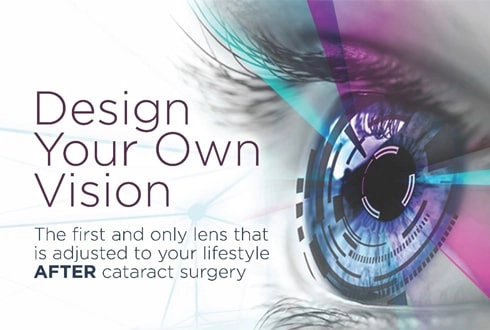
Light Adjustable Lens
(Astigmatism treated post-op)
The Light Adjustable Lens (LAL) is the only IOL that enables you and Dr. Hamilton to design, trial, and customize your vision after cataract surgery. Adjustability takes cataract surgery to the next level by giving you a lens customized specifically for your eyes.In an FDA study of 600 subjects, those who received the LAL were twice as likely (as those who received a standard monofocal IOL) to achieve 20/20 vision without glasses.
How Does a Light Adjustable Lens Work?
The Light Adjustable Lens is made of a special photo-sensitive material that changes the power of your implanted lens in response to UV light, increasing the likelihood that you will achieve your desired vision after cataract surgery.
If you select the Light Adjustable Lens, the first step is to have your cataract safely removed and the adjustable IOL implanted. The cataract removal and IOL implantation procedure are the same as if you selected a standard (non-adjustable) IOL.
Now for the unique part! After your eye heals, you return to your eye doctor to have your vision tested during a routine eye exam. Based on this exam, you and your eye doctor will select a custom prescription for your adjustable lens based on your own eyes and unique lifestyle requirements.
